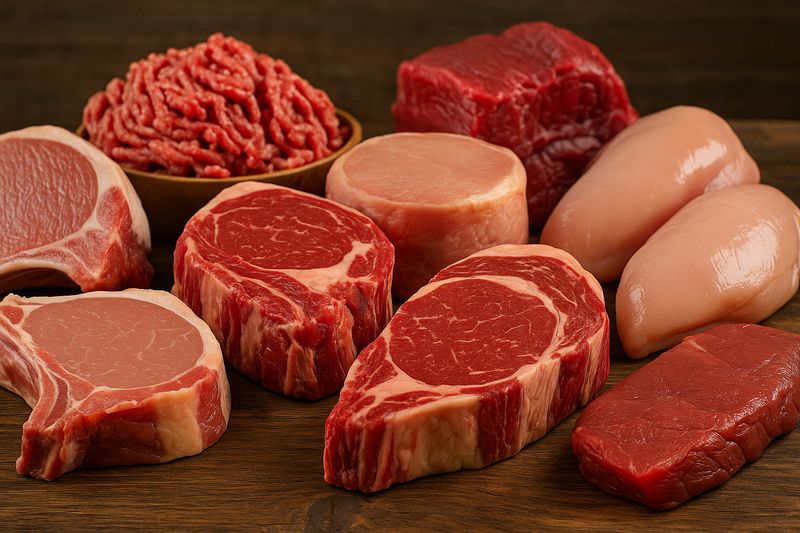
Published in News
Global Meat Market to Hit USD 2.3 Trillion by 2034
The global meat market is projected to reach USD 2.3 trillion by 2034, growing at a 7.2% CAGR as consumers demand more protein, convenience, and sustainable products.

Martina Osmak
Director of Marketing
Global Meat Market Overview
The global meat industry is entering a new era of growth and transformation. According to Towards FnB, the market is projected to rise from USD 1.23 trillion in 2025 to USD 2.30 trillion by 2034, registering a 7.2% compound annual growth rate (CAGR). This surge is driven by increasing protein consumption, expanding cold-chain infrastructure, and growing demand for convenient and value-added meat products.
The study highlights that Asia Pacific and North America will account for the largest share of market expansion, supported by changing consumer lifestyles, rising disposable incomes, and evolving food preferences.
Key Growth Drivers
1. Increasing Protein Consumption
With global awareness of health and nutrition on the rise, consumers are turning to high-protein diets. Meat remains a primary protein source, and demand continues to grow, particularly for poultry and seafood—two of the most affordable and accessible options worldwide.
2. Convenience Fuels Demand
Modern consumers want ready-to-eat and ready-to-cook options that save time without sacrificing nutrition. Pre-marinated meats, frozen cuts, and meat snacks are increasingly popular in supermarkets and online retail platforms, reflecting the fast-paced lifestyles of urban populations.
3. Sustainability Takes Center Stage
Producers are adopting eco-friendly and ethical practices such as reduced antibiotic use, improved waste management, and renewable energy adoption. Consumers are rewarding brands that prioritize animal welfare and transparent sourcing.
4. Artificial Intelligence in Meat Production
AI is revolutionizing how meat is processed, stored, and delivered. From robotic cutting systems and quality detection to AI-powered livestock monitoring, technology is improving efficiency and traceability. Smart algorithms also optimize cold-chain logistics, reducing spoilage and operational costs.
Emerging Trends in the Meat Market
Blended Meat Products: Combining traditional and plant-based proteins for flexitarian diets.
Ethically Sourced Meat: Rising demand for grass-fed, organic, and antibiotic-free options.
Flavor Innovation: Global cuisines and marinades are expanding consumer choices.
Digital Transparency: Traceability tools powered by AI are helping consumers make informed decisions.
Regional Highlights
Asia Pacific led the global market in 2024 thanks to its massive population, rapid urbanization, and growing cold-chain capacity. Poultry and seafood remain top sellers.
North America is forecast to grow quickly through 2034 as consumers seek premium, clean-label, and protein-rich products.
Middle East & Africa are emerging markets driven by halal-certified, frozen, and premium meat demand—especially in Saudi Arabia, the UAE, and South Africa.
Global Meat Trade Insights
Global meat trade reached around 40–42 million tonnes in 2024, representing about 10–11% of total meat output.
Top exporters: Brazil, the U.S., Australia, and the European Union.
Major importers: China, Japan, South Korea, and Gulf nations.
Trade remains influenced by tariffs, sanitary regulations, and sustainability standards, with traceability becoming essential to market access.
Leading Companies
JBS S.A. (Brazil) – The world’s largest meat producer with a strong sustainability focus.
Tyson Foods (USA) – Major innovator in automation and protein diversification.
Cargill (USA) – Integrated supply chain and global safety standards leader.
WH Group (China) – Largest pork producer through Smithfield Foods.
Hormel Foods (USA) – Known for premium and branded meat products.
CP Foods (Thailand) – Global leader in poultry and ready-meal exports.
Danish Crown (Denmark) – Focused on climate-neutral meat production.
Outlook: A Smarter, More Sustainable Future
As technology, sustainability, and health trends converge, the global meat market is evolving beyond traditional production. Companies that embrace AI-driven innovation, ethical sourcing, and eco-efficiency are set to dominate in the coming decade.
By 2034, the meat market’s journey to USD 2.30 trillion will reflect not only strong consumer demand but also a fundamental shift toward smarter, more transparent, and more sustainable food systems.
